Related Research Articles

Nina Simone was an American singer, songwriter, pianist, composer, arranger and civil rights activist. Her music spanned styles including classical, folk, gospel, blues, jazz, R&B, and pop. In 2023 Rolling Stone ranked Simone at No. 21 on their list of the 200 Greatest Singers of All Time.
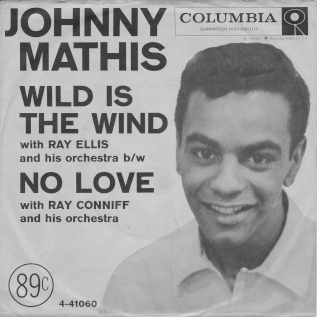
"Wild Is the Wind" is a song written by Dimitri Tiomkin and Ned Washington for the 1957 film Wild Is the Wind. Johnny Mathis recorded the song for the film and released it as a single in November 1957. Mathis' version reached No. 22 on the Billboard chart. It was nominated for an Academy Award for Best Song in 1958, but lost to "All the Way" by Jimmy Van Heusen and Sammy Cahn from The Joker is Wild.

Lisa Simone Kelly is an American singer, composer and actress, known for her work on and off Broadway, in Rent, The Lion King, Aida, and Les Miserables. She is the only child of musician and civil rights activist Nina Simone from her marriage to police detective Andrew Stroud and is the executive producer of the Netflix documentary What Happened, Miss Simone? Simone's albums include Simone on Simone, All is Well, My World, and Live at the Edge.

Let It All Out is an album by Nina Simone, released by Philips Records in February 1966.

Baltimore is the fourteenth studio album by American singer-songwriter and pianist Nina Simone, released in January 1978 by CTI Records. Due to a lack of promotion, and Simone's dissatisfaction with the record, It became a commercial failure, failed to chart, and also received mixed reviews from critics. It would also become her first and only album released under her contract with CTI Records. The title track was originally written and recorded by Randy Newman in 1977.
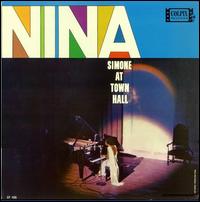
Nina Simone at Town Hall is the first live album by Nina Simone, released in December 1959. It was her third album of that year, her second album for Colpix Records, and her first live album. The basis for the record was Simone's performance at the Town Hall, New York, on 12 September 1959. All of the songs performed at the concert are on the album; however, three of the tracks are studio versions cut the following month.

Nina Simone at Newport is a live album by jazz singer and musician Nina Simone. It was released in August 1960; the recording taken from a concert held at the Newport Jazz Festival earlier in the year, on 30 June 1960. The album was her fourth overall, and her third for Colpix; it was also her second live album, following on from Nina Simone at Town Hall (1959) released at the end of the previous year. All arrangements on Nina Simone at Newport were written by Simone, and it was produced by Stu Phillips.

Forbidden Fruit is the third studio album by Nina Simone. It was her second studio album for Colpix. The rhythm section accompanying her is the same trio as on both live albums before and after this release.

Nina Simone at the Village Gate is a live album by singer Nina Simone. Released in early 1962, it was her third live album for Colpix. The album was recorded at The Village Gate, a nightclub in Greenwich Village, New York in late March 1961, nearly a year before it saw release. The original release featured eight of the twelve songs performed at the gig. In 2005, an extended version of the album was released with the four remaining tracks.
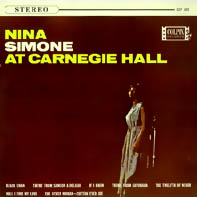
Nina Simone at Carnegie Hall is a 1963 album by jazz singer/pianist/songwriter Nina Simone. It is a live album recorded at Simone's first solo appearance at Carnegie Hall in New York City, on April 12, 1963, and was released on Colpix Records.

Little Girl Blue: Jazz as Played in an Exclusive Side Street Club is the debut studio album by Nina Simone. Recorded in late 1957, it was eventually released by Bethlehem Records in February 1959. Due to the length of time the album had taken to be released and the lack of any promotional single either immediately before or alongside the album, Simone would become disillusioned with Bethlehem and sign with Colpix Records in April 1959. She recorded the tracks for her second album - what would become The Amazing Nina Simone - the same month. However, in May Bethlehem finally released a single, "I Loves You, Porgy" and gave Simone her first hit later that year, peaking at number 18 on the pop charts, and number 2 on the R&B charts. Helped by the profile of the single, the album too went on to become a chart success.
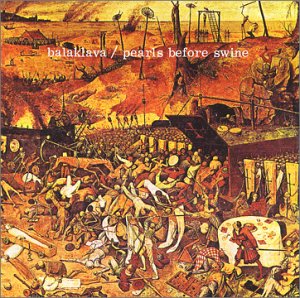
Balaklava was the second album recorded and released by psychedelic folk group Pearls Before Swine in 1968.
"Four Women" is a song written by jazz singer, composer, pianist and arranger Nina Simone, released on the 1966 album Wild Is the Wind. It tells the story of four African American women. Each of the four characters represents an African-American stereotype in society. Thulani Davis of The Village Voice called the song "an instantly accessible analysis of the damning legacy of slavery, that made iconographic the real women we knew and would become."
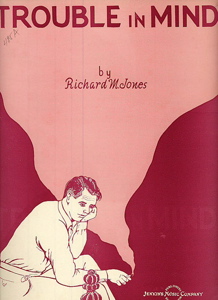
"Trouble in Mind" is a vaudeville blues-style song written by jazz pianist Richard M. Jones. Singer Thelma La Vizzo with Jones on piano first recorded it in 1924 and in 1926, Bertha "Chippie" Hill popularized the tune with her recording with Jones and trumpeter Louis Armstrong. The song became an early blues standard, with numerous renditions by a variety of musicians in a variety of styles.

Arthur Adams is an American blues guitarist from Medon, Tennessee. Inspired by B.B. King and other 1950s artists, he played gospel music before attending college. He moved to Los Angeles, and during the 1960s and 1970s he released solo albums and worked as a session musician. In 1985 he was tapped to tour on bass guitar with Nina Simone, and he staged a comeback in the 1990s when he released Back on Track, and became a respected Chicago blues player and bandleader in B.B. King's clubs.
Women in jazz have contributed throughout the many eras of jazz history, both as performers and as composers, songwriters and bandleaders. While women such as Billie Holiday and Ella Fitzgerald were famous for their jazz singing, women have achieved much less recognition for their contributions as composers, bandleaders and instrumental performers. Other notable jazz women include piano player Lil Hardin Armstrong and jazz songwriters Irene Higginbotham and Dorothy Fields.
James Edward Bond Jr., known as Jimmy Bond, was an American double bass player, arranger and composer who performed and recorded with many leading jazz, blues, folk and rock musicians between the 1950s and 1980s.

Vladimir Sokoloff was an American pianist and accompanist on the faculty of the Curtis Institute of Music. In addition to his teaching work with the accompanying, piano and chamber music students, he was an active performer.

The Amazing Nina Simone is a 2015 American documentary film by director Jeff L. Lieberman. The film details the life, legacy and musical accomplishments of singer, musician, pianist, songwriter and Civil Rights activist, Nina Simone through interviews with over 50 of her friends, family, band members, lovers and fellow activists. The film has been called the best of the three Nina Simone films by The New Yorker Magazine, and "The Nina Simone film we should all be watching" by Blavity.
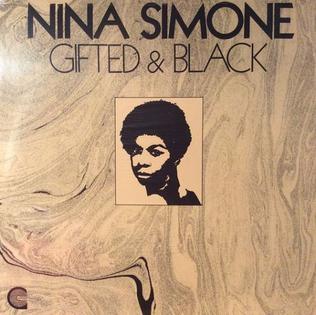
Gifted & Black is an unofficial studio album from jazz singer, pianist, and songwriter Nina Simone. It was originally released in 1970 by Canyon Records. However, it is thought to be a demo tape made by Simone in the spring of 1957 some months before the recording of Little Girl Blue, her first official album, in December of the same year. For the release in 1970, the original recording had strings added.
References
- 1 2 Remy Tumin, "Still Keeping the Beat for Nina Simone", August 24, 2015. Retrieved 22 January 2019
- ↑ Denise Sullivan, "Nina Simone Would've Been 80 Today", February 21, 2013. Retrieved 22 January 2019
- ↑ Alan Light, What Happened, Miss Simone?, Canongate Books, 2016, ISBN 978-1-78211-871-8, pp.49-52
- ↑ Alan Light (2016). What Happened, Miss Simone? A Biography. Crown Archetype, ISBN 978-1-101-90487-9
- ↑ Al Schackman Credits, Discogs.com. Retrieved 22 January 2019